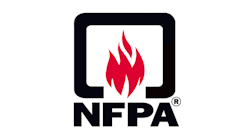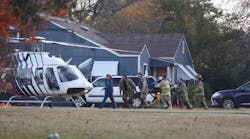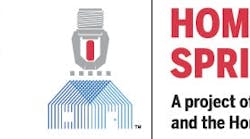August 23, 2023 – As the new school year draws near, college students across the country are preparing to move to campus in a dormitory or off-campus housing. Through their annual “Campus Fire Safety for Students” campaign in September, the National Fire Protection Association® (NFPA®) and The Center for Campus Fire Safety (CCFS) are working together to help ensure these residences are as safe as possible for students.
Campus Fire Safety Month raises awareness about the threat of fires in both on- and off-campus housing, putting relevant information in the hands of students, their parents, and campus housing staff and administrators, helping students make living spaces as safe as possible from fires and associated hazards.
According to CCFS, from January 2000 to April 2023, 94 fatal fires occurred on a college campus, in Greek housing, or in off-campus housing within three miles of the campus, claiming 134 lives. Of the 94 fires, 38 were accidental involving cooking, candles, smoking, or electrical equipment, and resulted in 51 student fatalities.
In addition, according to NFPA’s latest “Fires in Dormitory-Type Properties” report, between 2017 – 2021, U.S. fire departments responded to an estimated average of 3,379 structure fires each year in dormitories, fraternity houses, sorority houses, and barracks. Fires in dormitory-type properties caused an annual average of 23 civilian injuries and $12 million in direct property damage during that period. Approximately three out of four fires in these properties began in the kitchen or cooking area, accounting for 60 percent of the civilian injuries and 17 percent of the direct property damage. Cooking equipment was involved in nearly 9 out of 10 fires.
Following are additional statistics from the report:
- The months of February, September, and October were peak times for fires in dormitory properties.
- Fires were more common during the evening hours between 4 p.m. and midnight when over half of the fires (54 percent) occurred.
- Kitchen and cooking equipment were involved in 86 percent of the fires.
- Fires were also more common on weekends with Saturday and Sunday being the leading days for fire events.
“As students return to campus this fall, many of them will be preparing their own meals, some using kitchen appliances for the first time or cooking food after coming home late from studying or a party,” said Lorraine Carli, vice president of Outreach and Advocacy at NFPA and CCFS Advisory Council member. “The numbers tell us that more education is needed around when and where cooking hazards exist, along with ways to prevent them. Campus Fire Safety Month is a great opportunity to share information and resources that help raise awareness of fire safety on our college campuses.”
NFPA and CCFS offer these tips and recommendations for cooking safely in dorms and in off-campus housing:
- Stay in the kitchen when frying, grilling, or broiling food. If you must leave the kitchen, even for a short time, turn off the stove or oven.
- Turn pot handles toward the back of the stove. Always keep a lid nearby when cooking. If a small grease fire starts, slide the lid over the pan and turn off the burner.
- Cook only when alert. Don’t cook if you are sleepy or have taken medicines or consumed alcohol that make you drowsy.
- Set a timer for a reminder that you are cooking.
- Keep anything that can catch fire (towels, potholders, etc.) away from the stovetop.
- Check with the local fire department for any restrictions before using a barbeque grill, fire pit, or chimenea.
- If a fire starts in the oven, turn it off and leave the door closed. Have the oven checked and/or serviced before using it again.
- If you have any doubt about fighting a small fire, get out and call the fire department. When you leave, close the door behind you to help contain the fire.
These additional tips from NFPA and CCFS can help students reduce the risk of fires and save lives:
- Know and practice the building’s evacuation plan, as well as alternate routes out of the building.
- Test smoke alarms monthly in an apartment or a house. Ensure smoke alarms are installed in all sleeping areas, outside of all sleeping areas, and on every level of the apartment or house. Never remove or disable smoke alarms.
- Keep combustible items away from heat sources and never overload electrical outlets, extension cords, or power strips. Many fires are caused by portable light and heat sources, like space heaters and halogen lamps.
- Keep common areas and hallways free of possessions and debris. Never block exit routes.
Many of the resources, including videos, checklists, infographics, and tips sheets are designed to be shared through social media, school newspapers, college websites, and posted in dormitory common areas.
For more information about the Campus Fire Safety for Students campaign and to find free resources, visit nfpa.org/campus and the CCFS Share! For Students webpage.
For this release and other announcements about NFPA initiatives, research, and resources, please visit the NFPA press room.
About The Center for Campus Fire Safety (CCFS)
CCFS is the voice of over 4,000 campus fire and life safety officials. With its roots in the first Forum on Campus Fire Safety in 1999, at NFPA Headquarters in Quincy, Massachusetts, CCFS has advocated for fire safety at the nation's institutions of higher education for over 22 years, incorporating as a non-profit in 2005. CCFS is a membership-based organization devoted to reducing the loss of life from fire at colleges and universities, both on and off-campus. CCFS members and followers reach throughout North America with growing international membership. Visit us at: http://www.myccfs.org
About the National Fire Protection Association® (NFPA®)
Founded in 1896, NFPA® is a global self-funded nonprofit organization devoted to eliminating death, injury, property and economic loss due to fire, electrical and related hazards. The association delivers information and knowledge through more than 300 consensus codes and standards, research, training, education, outreach and advocacy; and by partnering with others who share an interest in furthering the NFPA mission. For more information, visit www.nfpa.org. All NFPA codes and standards can be viewed online for free at www.nfpa.org/freeaccess.







